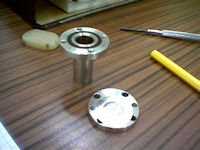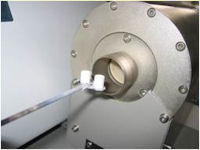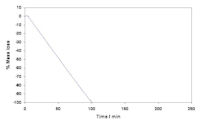Thermodynamics of CVD Precursors
Properties of CVD-Precursors
Description
In Chemical Vapor Deposition (CVD), the substances that are required for the desired films are introduced into the reactors with so-called precursors. For metallic films, many different organo-metalic substances are used, since their vapor pressures are most often considerably higher than those of the inorganic compounds of the metals. This reduces the needed evaporation temperatures below 150°C. The same substances are also used for the production of nanoparticles from the gas phase in Chemical Vapor Synthesis processes (CVS), thus they are also used by many groups within CeNIDE. However, the vapor pressures of these either solid or liquid compounds are often in the range between 0.1 and 1000 Pa at temperatures between room temperature and 150°C. This is a vapor pressure range which is not investigated routinely. If, however, CVD processes or nanoparticle formation processes shall be up-scaled for industrial processes, the vapor pressure of each compound is an important parameter for the process design.
Even more important for the use of organo-metalic compounds in reproducible systems is the finding that some precursors start to decompose slowly at evaporator temperatures. Thus, the thermal stability of each substance has to be evaluated carefully. Finally, for the design of evaporators the diffusion coefficients of the evaporating compounds are needed, in order to calculate the Sherwood number as a function of the Schmidt number.
These three properties are investigated with gravimetric methods:
- The stability is studied in thermogravimetric experiments and can be deduced either from the form of the mass loss curve or from the residual remaining after long times. This is investigated in isothermal experiments in order to have comparable conditions to typical evaporators. To ensure that the decomposition is not caused by air or moisture, the thermo-balance is situated in a glove box with a well defined inert gas atmosphere, where the oxygen content is monitored.
- If the compound turns out to be stable, the vapor pressure is generally investigated with the Knudsen effusion method for several temperatures. This can also be done with a Knudsen cell directly coupled to a micro balance.
- With the known vapor pressure, the diffusion out of a cylindrical crucible, as it is used in the thermo-balance, can be used to determine the diffusion coefficient as a function of temperature. Recently, quartz crystal microbalances are also used for these investigations.
Numerous organo-metalic compounds have already been studied at Duisburg with this method, often in cooperation with groups from inorganic chemistry (Prof. Zenneck, Erlangen; Prof. S. Schulz, Duisburg, Prof. Lang, Chemnitz).
References
- M. Aslam Siddiqi, Rehan A. Siddiqui, Burak Atakan, Nina Roth and Heinrich Lang ; Thermal Stability and Sublimation Pressures of Some Ruthenocene Compounds; Materials 2010, 3(2), 1172-1185; doi:10.3390/ma3021172.
- M. Aslam Siddiqi, Rehan A. Siddiqui and Burak Atakan ; Thermal Stability, Vapor Pressures, and Diffusion Coefficients of Some Metal 2,2,6,6-Tetramethyl-3,5-heptandionate [M(tmhd)n] Compounds; J. Chem. Eng. Data, Article ASAP; DOI: 10.1021/je9006822
- M. Aslam Siddiqi, Rehan A. Siddiqui, Burak Atakan; Thermal stability, sublimation pressures and diffusion coefficients of some metal acetylacetonates; SURFACE & COATINGS TECHNOLOGY 201 (2007) 9055-9059 SEP 25 2007.
- Andreas Schneider, Nadejda Popovska, Ilona Jipa, Burak Atakan, M.Aslam Siddiqi, Rehan Siddiqui, Ulrich Zenzek; Minimizing the carbon content of thin ruthenium films by MOCVD precursor complex design and process control; CHEMICAL VAPOR DEPOSITION 2007,13,389-395 AUG 2007.
- M. Aslam Siddiqi and Burak Atakan; Combined experiments to measure low sublimation pressures and diffusion coefficients of organometallic compounds; Aviable online 6 December 2006; Thermochimica Acta 452(2007) 128-134.




